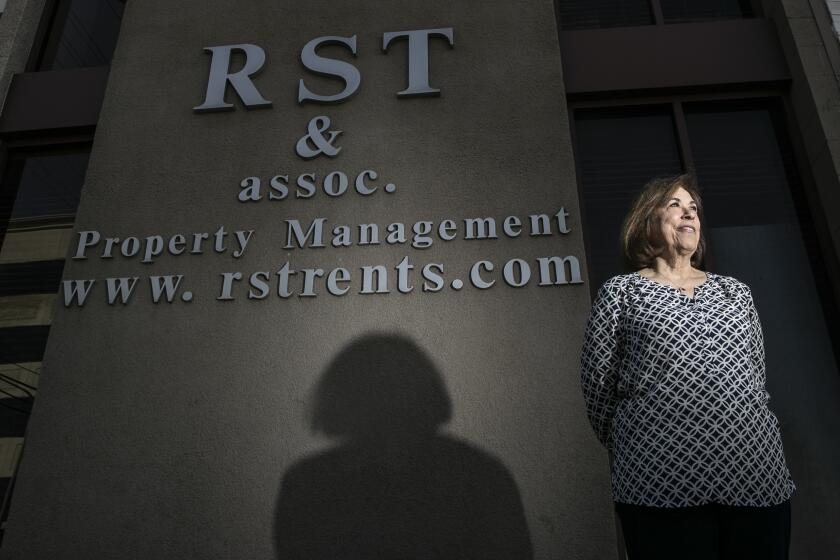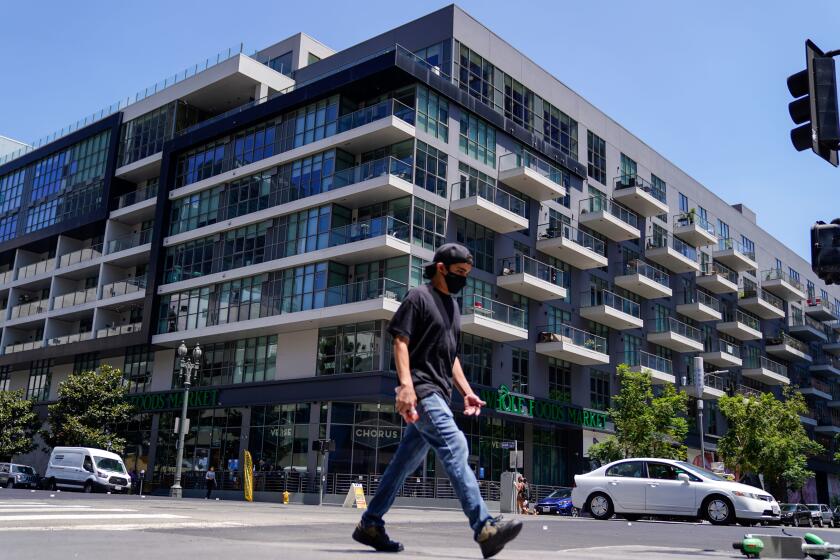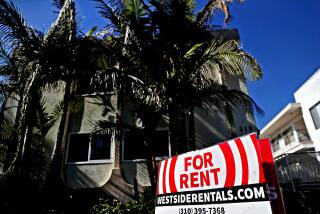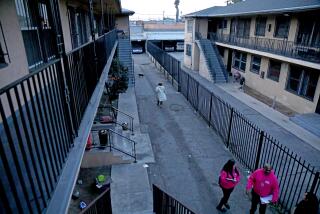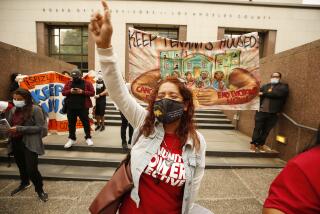‘It’s very scary’: Tenants on edge as California mulls extending eviction moratorium
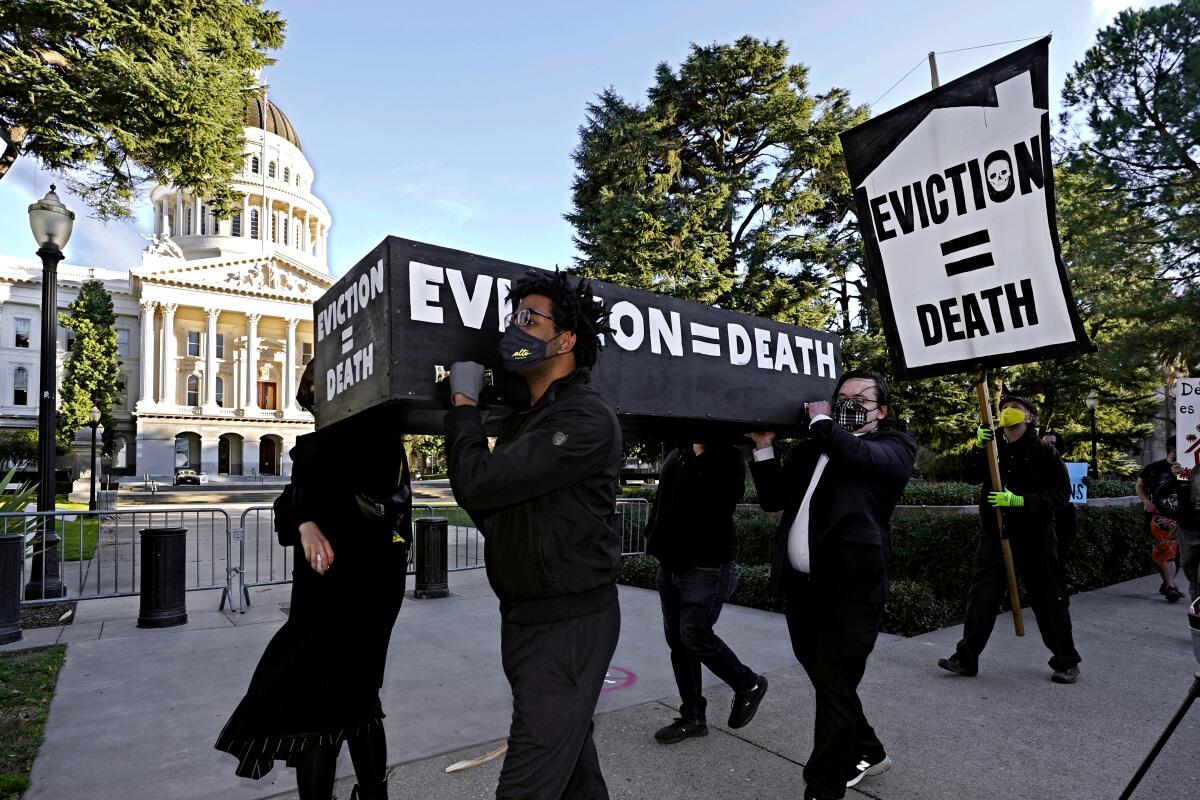
Some regulations that have protected California renters from eviction during the pandemic are nearing expiration, leaving many tenants worried about how they will stay housed and underscoring the uneven recovery from COVID-19’s economic toll.
The statewide moratorium on evictions, which protects renters with pandemic-related hardships if they don’t pay rent, is due to expire at midnight June 30. Gov. Gavin Newsom is expected to announce an agreement with legislative leaders for an extension this week.
Though some form of extension at the state level is expected, tenants and their advocates say the uncertainty hanging over what happens next — and layers of rules that many people find confusing — is sowing anxiety and fear.
“I don’t know what I am going to do,” said Natalia Cole, a 38-year-old Eureka resident who was laid off from her warehouse job in December and is $4,000 behind on rent. She said her landlord has applied for rental relief on her behalf, but so far she has heard nothing about her application. “I’m at a standstill.”
A lapse in the state protections would leave people at risk of losing their housing next month if they can’t pay July’s rent, as well as a portion of the accumulated debt they owe. Even as business and the economy have begun to recover, many people — especially low-income households — are still struggling to secure their basic needs.
California has passed a raft of assistance aimed at protecting the neediest — much of it difficult to navigate, from understanding the rules to applying for help, tenants and their advocates say. Because there are separate regulations at some county and city levels, eviction protections are set to continue beyond June 30 in some corners of California, including L.A. County, no matter what the state does.
Millions of Americans, especially low-income tenants, are accumulating debt amid the COVID-19 pandemic, threatening to create a downward financial spiral.
On Tuesday, the Los Angeles County Board of Supervisors voted to bar evictions for nonpayment of rent through the end of September in L.A. County if the tenant can’t pay because of a pandemic-related financial hardship.
And the city of Los Angeles has avoided the renewal debate altogether: The city’s law bars landlords from evicting tenants with pandemic-related financial hardship for not paying their rent until the city lifts its March 2020 emergency declaration. When that might happen is unknown, but when it is lifted tenants will have to pay the next month’s rent in full but have 12 months to pay back their past due rent.
The state and many localities are distributing billions of dollars in federal rental assistance, and Newsom has proposed to pay 100% of what low-income tenants owe in unpaid rent. But the rollout of the funds has been slow, angering both tenants and landlords.
Landlord groups say small property owners are particularly at risk if they don’t get the money soon or have the ability to remove tenants who aren’t paying. Meanwhile, tenants are peppering community organizations with questions over their rights that can’t yet be answered. Some are drawing up contingency plans.
Before L.A. County extended protections Tuesday, one Torrance resident said she planned to pay her July rent with credit cards. Some tenants, anticipating the expiration, have already borrowed money to clear rent debt before next week, said Ugochi L. Anaebere-Nicholson, directing attorney at the Public Law Center in Orange County.
René Christian Moya, campaign coordinator at the low-income advocacy group Alliance of Californians for Community Empowerment, said some tenants are self-evicting because they don’t expect to receive rent relief payments before June 30.
“A lot are freaked out,” said Ernie Reguly, senior housing attorney with Riverside Legal Aid. “People ask me what is going to be the law and I don’t know.”
Since the beginning of the pandemic, local, state and federal governments have employed a patchwork of limited eviction moratoriums to keep people housed and minimize the spread of disease.
Tenant attorneys say the measures are overly complicated with too many loopholes that disadvantage tenants. For example, the rules don’t prohibit landlords from filing eviction cases, meaning tenants must know their rights and respond in court, or they could face a default judgment and loss of their housing.
But on a whole, the restrictions have led to eviction rates that have plunged from pre-pandemic levels, and each time restrictions have come up for expiration in the last year, advocates raise concern of a looming eviction cliff.
The state rules, which like the L.A. County measure bar nonpayment evictions for those with pandemic-related financial hardships, were extended once before. Back then, the deal was announced a week before the protections were due to expire Feb 1.
New data show how property owners in Los Angeles — especially mom-and-pop landlords — are having trouble paying mortgages and keeping up with maintenance costs as their tenants miss rent.
Landlord groups say fears over mass evictions are misplaced, in part because property owners typically want to avoid what can be a time-consuming and expensive process.
Scott Collier, a managing director at national apartment owner TruAmerica Multifamily, said that when protections expire, the company will turn to repayment plans to keep people in their housing. Other apartment owners and management firms have said they have similar plans.
At some point, TruAmerica would need to ask nonpaying tenants to leave, with a formal eviction the last resort, but several factors are likely to prohibit the feared wave, at least in California, Collier said.
State rules say landlords can’t evict over missed rent from March 2020 through the end of August of that year. And if on or before June 30, a renter pays 25% of what they missed between Sept. 1, 2020, and June 30, 2021, landlords can’t evict over the remainder and can only collect it in small-claims court.
Property owners could evict someone for not paying full July rent. But with business restrictions broadly lifted now and the economy on the mend, Collier expects new or recovered income for those who struggled to make ends meet previously.
“With this recovery will come the ability to actually pay rent,” Collier said.
In California, the percentage of tenants behind on rent was 12% in late May, down from 21% in December, according to an analysis of census surveys conducted by PolicyLink, a nonprofit dedicated to racial and economic equity.
Sarah Treuhaft, vice president of research at PolicyLink, said the numbers are an improvement but indicate an ongoing crisis that necessitates continued protections.
Some 758,000 California households had unpaid rent as of late May, the nonprofit estimates, collectively owing $3.5 billion, or $4,700 each on average. Most of those households were low income and people of color, groups that have been disproportionately affected by the pandemic.
Ditching protections now would be dire, Treuhaft and tenant advocates say. Rent is rising after declining in many big cities during the pandemic, giving landlords more incentive to replace struggling tenants with those who can pay, particularly those in rent-controlled units who had been paying way below the market rate.
The Lowery family in Antioch is one among many fretting over June 30. Jackie Lowery, who is retired due to health issues, lives with family members who were all laid off during the pandemic. None have been able to find work that will cover all the household bills, Lowery said. For now, unemployment checks have covered 25% of their rent.
If the state protection measure expires next week, she said, they’ll be forced to delay paying their water and power bills to cover the full July rent for their house — $3,000. Like Cole, Lowery has been working with the Alliance of Californians for Community Empowerment to push for an extension.
Federal rent relief funds are designed to stave off such choices by compensating landlords, who at times have housed people for free during the pandemic and have reported growing difficulty paying their own bills.
With California’s economy reopening, rent in Los Angeles and other big cities is beginning to rise.
But applications for those federal funds, as well as their distribution, have been slowed by confusion, extensive documentation requirements and other issues, according to organizers helping tenants with the process. The problems also include no or limited internet access for many very-low-income households that are most likely to have rent debt.
Lowery said her family applied for federal aid in March but hasn’t heard back. If her family racks up other debt to pay July’s rent, she would have protection against eviction that month, even if the state protections expire, according to state rules. But if rent relief money doesn’t arrive, she fears she’ll be forced out anyway.
Though property owners couldn’t specifically evict her over the 75% of rent she owes, in Antioch she can be forced to move if an owner wants to move in.
“They are so deep in the hole,” she said of landlords across the state, including hers. “They might say, ‘Hey, I just have to sell the property and get my money.’”
As Lowery awaits a state decision, she said she’s trying to shield her family from the uncertainty. That includes her twin 6-year-old granddaughters who live with her and often mention how they love the house, where they enjoy water balloon fights in the backyard.
Cole, on the other hand, said she can’t pay July’s rent, nor the 25% of back rent, without rent relief. She’s now considering moving into her car.
“It’s really scary,” she said.
The California Apartment Assn. says it’s open to a brief extension of the state eviction restrictions but wants more to be done to ensure those protected truly need help because it says too many tenants are able to pay but are taking advantage of rules to live for free.
“The problem is when we have tenants who won’t cooperate and have not cooperated from Day One,” said Debra Carlton, the association’s executive vice president of public affairs.
Moya of the Alliance of Californians for Community Empowerment said he hasn’t come across tenants who could pay but don’t, but rather he’s seen people take out high-interest loans to pay their landlords. He said additional requirements for protections would mean more opportunities for people to fall through the cracks, and he wants eviction protections extended until unemployment drops below pre-pandemic levels.
Russ Heimerich, spokesman for the state agency overseeing the state distribution, said the rent relief application has recently been streamlined and the daily number of applications has risen by 70% since. The time it takes the state to approve applications has also dropped.
More federal money is on the way, which would be enough to cover all of the state’s back rent, at least as measured by PolicyLink.
“Right now is not the time to let protections lapse and risk homelessness, eviction and other inequities,” Treuhaft said, noting the rental assistance program “is just getting off the ground.”
More to Read
Inside the business of entertainment
The Wide Shot brings you news, analysis and insights on everything from streaming wars to production — and what it all means for the future.
You may occasionally receive promotional content from the Los Angeles Times.

